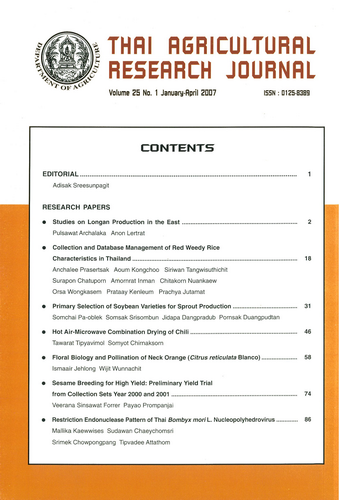Floral Biology and Pollination of Neck Orange (Citrus reticulata Blanco)
DOI:
https://doi.org/10.14456/thaidoa-agres.2007.2Keywords:
neck orange, Citrus recticulata, floral biology, pollination, pollinators, fruit set, floral nectarAbstract
This study on the floral biology and pollination of neck orange (Citrus reticulat Blanco) was conducted at the cirtrus collection plot of the Department of Plant Science, Faculty of Natural Resources. at the citrus collection plot of the Department of Plant Science, Faculty of Natural Resources, Prince of Songkla University and in a farmers orchard located in Hat Yai district, Songkhal province from January to November 2005 with 2 investigations. First, the morphology, biology and anatomy of neck orange flowers were investigated. Its flower consisted of 5 green sepals, 5 white petals, 20 stamens and a superior ovary. The flowering duration ws an average of 17 days per tree with a peak of flowers on day 8 and a diurnal opening peak at 10:00 am. The pollen was prolate shaped, had 4 colporate apertures and a reticulate exine of 1.14 microns. There was an average of 10,869 pollen grains per flower. They had a high initial viability of 90.1% that decreased slightly to 62.1% after 48 hours storage. The pollen penetrated the ovary within 3 hour with the highest peak at 48 h. The receptivity of the pistil to pollen penetration was the hightest within 3 hours of the flower opening. The morphology of the stigma at maturity had an expanded shape with a semi-hollow stigmatic groove. The second investigation was a pollination experiment to test the effect of cross pollination, open pollination and non pollination on the initial fruit set. It was found that hand cross pollination within the same species had the highest fruit set 40%, followed by open pollination with 22% fruit set, while no pollinations gave only 3% fruit set. The most insects to influential the pollination of the neck orange as in order, were the natural oriental fruit fly (Bactrocera dorsolis Hendel), stingless bees (Trigona sp.,), carpenter bess (Xylocopa sp.) and black ant (Camponotus sp.). These insects visited the opened flowers to suck floral nectar and pollinated the flowers from the early morning
secreted nectar in the flowers of the neck ornge t 3.83 u / flower occurred just after anthesis at 9.00 a.m. and then the secretion slightly decreased to the lowest level of 0.1 ui / flower at 5.00 pm. The nectar was composed of glucose, fructose and sucrose at 36.75, 42.21 and 81.9 ug / ml respctively.
Downloads
Published
How to Cite
Issue
Section
License
Copyright (c) 2017 วารสารวิชาการเกษตร (Thai Agricultural Research Journal)

This work is licensed under a Creative Commons Attribution-NonCommercial-NoDerivatives 4.0 International License.
Thai Agricultural Research Journal



